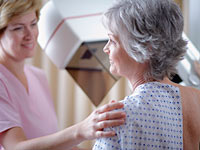AARP Hearing Center
Mammogram Debate: Is Screening Overdone?
By Candy Sagon, November 27, 2012 08:00 AM

"Screening saves lives" has long been the mantra of breast cancer groups and doctors. But a longtime critic of Americans' zeal for screening says new research shows that up to a third of cancers detected through routine mammograms may not be life-threatening.
The study, which looked at three decades of government data on early-stage breast cancer in women over 40, found that 70,000 women a year may have been overdiagnosed for breast cancer and needlessly treated.
"It's a lot of women. It's a very substantial harm," study coauthor H. Gilbert Welch, M.D., of The Dartmouth Institute for Health Policy & Clinical Practice in New Hampshire, told Reuters. The study was published in the New England Journal of Medicine.
The study touched off another round in the controversy over the benefits of screening, with many radiologists and other experts criticizing the research for implying that women shouldn't get a routine mammogram unless they have symptoms - like a lump in their breast - or a family history of the disease that could put them at a higher risk.
Welch has long focused his research on the downside of overscreening, including for the PSA test for prostate cancer in men. A similar study he did in 2009 suggested that 1 million American men since 1986 had been treated for prostate tumors that may never have killed them or even caused symptoms. "In general, the benefits of screenings have been vastly oversold and the harms have been totally ignored" or downplayed, he told Forbes magazine at the time.
He voiced similar concerns about mammograms, saying overscreening can cause a large number of women to be told they have cancer and then be treated unnecessarily with chemotherapy, radiation and surgery. (Keep in mind that this study was of women who had no symptoms until they went in for a routine mammogram, which detected a tiny growth.)
Because the study is a statistical analysis, there's no cellular examination of the types of tumors that supposedly turn out to be harmless. Rather, his reasoning is that if annual mammogram screening was really saving lives by detecting these early-stage cancers, there would be a greater-percentage drop in how many advanced-stage cancers were detected.
But while mammograms more than doubled the number of early-stage cancers detected, from 112 to 234 cases per 100,000 women, late-stage cancers dropped just 8 percent, from 102 to 94 cases per 100,000 women, his research showed.
The imbalance suggests a lot of overdiagnosis from mammograms, which now account for 60 percent of cases that are found, study coauthor Archie Bleyer, M.D., of St. Charles Health System in Oregon, told the Associated Press.
But breast cancer experts criticized the research as harmful to women and said it was part of a coordinated campaign to cut back on the tests to reduce health care expenses, the Los Angeles Times reported.
"This is simply malicious nonsense," Daniel B. Kopans, M.D., a senior breast imager at Massachusetts General Hospital in Boston told the Times. "It is time to stop blaming mammography screening for 'overdiagnosis' and 'overtreatment' in an effort to deny women access to screening."
Debra Monticciolo, M.D., a spokeswoman for the American College of Radiology and president of the Society of Breast Imaging, called the paper an "extensive analysis based on false assumptions."
She told Reuters that the researchers' "best-guess estimate" about the annual breast cancer rate over the study period was much too low. "If you recognize that breast cancer had been increasing for 1 percent per year, there is no overdiagnosis," she said.
Mammograms are an imperfect screening tool. Three years ago the U.S. Preventive Services Task Force, a government advisory panel, issued new guidelines, recommending that women start routine mammograms at age 50 rather than 40, in part because the tests have a high false-positive rate, which can lead to undue worry and anxiety.
Women who are at increased risk, however, because of family history, certain genetic characteristics or other risk factors, may begin screening at age 40 and have mammograms more often, the panel said.
And Welch emphasized that women who develop symptoms, such as a lump in the breast, should not hesitate to get a mammogram.
"No one argues about the value of diagnostic mammography," he told the Los Angeles Times. "The question is whether we should invite women, coerce them, threaten them, scare them, to come get checked when nothing's wrong."
In other health news:
3-D mammograms may have fewer false positives. In round two of the recent mammogram debate, the Wall Street Journal reports that a new 3-D mammogram catches more cancers while causing fewer false alarms, according to the company that sells it. The downside, some physicians say, is that it costs more and delivers twice as much radiation as traditional mammograms.
Indian-made generic Lipitor recalled. Ranbaxy Pharmaceuticals Inc. has recalled dozens of lots of its generic version of cholesterol drug Lipitor because some may contain tiny glass particles, the latest in a string of manufacturing deficiencies that once led U.S. regulators to bar imports of the Indian company's medicines, according to the Associated Press.
Photo: Corbis































































